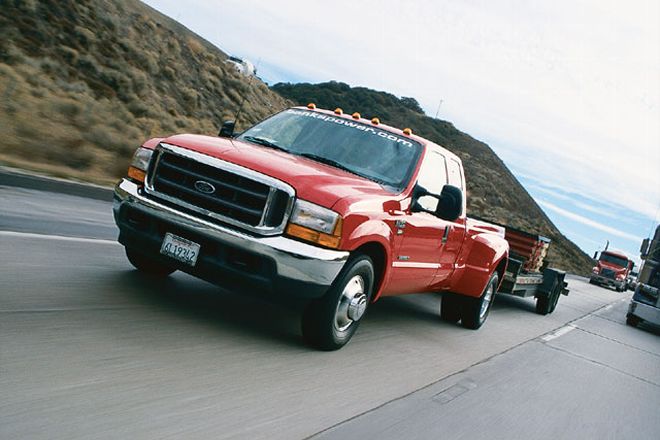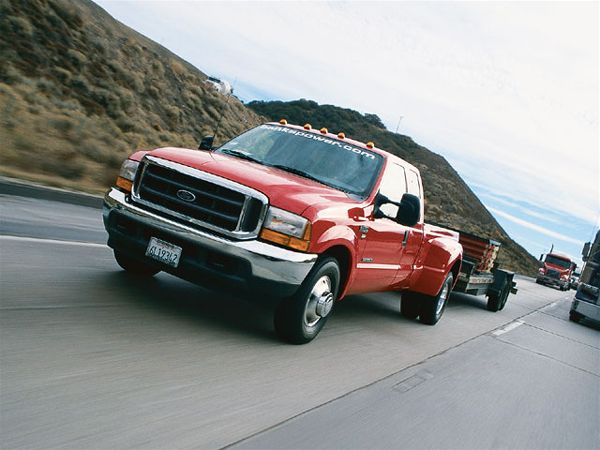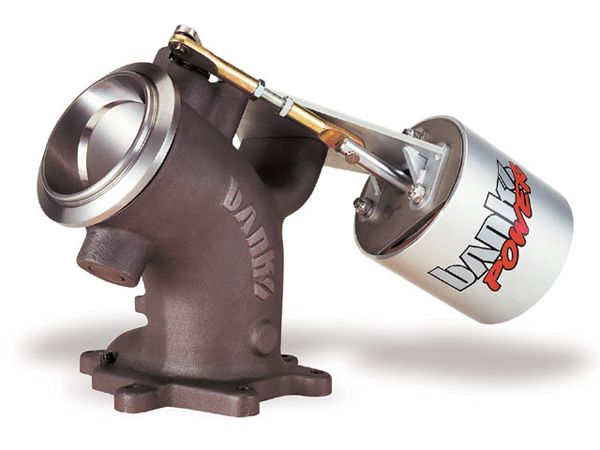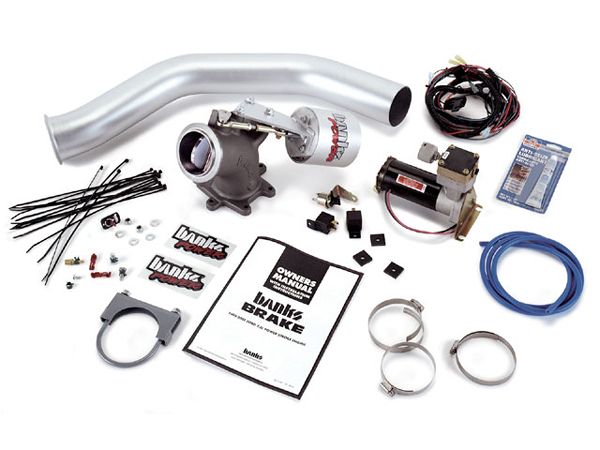
 Drew Hardin
Contributor
Photographers:
Banks Power
Drew Hardin
Contributor
Photographers:
Banks Power

Ever had this happen? You're flat-towing your 4x4 through the mountains and there's a particularly long downgrade up ahead. Maybe your brakes are already a little hot, the pedal is a bit spongy, and you're worried about holding your speed down the hill. About now you're envious of the big-rig truckers and their jake brakes. Hey, what's that smell? Not the brakes, is it?
Getting to the trail head and home again should not be this nerve-wracking. If you tow with a diesel truck, you can eliminate a lot of this worry by installing a supplemental exhaust braking system. It's not a jake brake, but it does use engine power to supplement your wheel brakes. (See the accompanying What's a Jake Brake? story for how the big-rig setups work.)
 Here's the brake unit by itself. The canister attached to the back is the vacuum actuator that controls the butterfly. The brake housing has a conical shape that helps direct the turbulent exhaust gas from the turbo into the main exhaust stream. So when the butterfly valve is open, the brake actually improves exhaust gas flow.
Here's the brake unit by itself. The canister attached to the back is the vacuum actuator that controls the butterfly. The brake housing has a conical shape that helps direct the turbulent exhaust gas from the turbo into the main exhaust stream. So when the butterfly valve is open, the brake actually improves exhaust gas flow. One of the newest exhaust brake systems on the market is the Banks Brake from Banks Power. If you're a diesel fan, you're probably already aware of the wide range of performance products that come from Gale Banks' Southern California engineering facility. Banks Brakes currently are available for '94-'02 Ford Power Stroke diesels and the Cummins engines in '94-'02 Dodge trucks. GM Duramax applications will be available in the spring of 2002.
The main component of the Banks Brake system is an elbow-shaped housing that bolts between the turbocharger outlet and the downpipe to the exhaust system. Inside the housing is a vacuum-operated butterfly valve. When the system is switched on, a control valve senses when the driver lifts off the accelerator pedal and closes the butterfly valve. This causes exhaust backpressure to build behind the turbocharger. As the engine's exhaust valves open during their normal cycling, the waste gas trying to escape pushes on the air mass accumulating in the pipeline. This slows the engine's reciprocating assembly, which in turn slows the forward progress of the truck. As soon as the driver hits the accelerator pedal again, the butterfly valve opens and the exhaust is free to leave.
 The Banks Brake kit comes with the brake unit, vacuum actuator pump, new stainless-steel outlet pipe, wiring loom, and all the hardware needed for the install.
The Banks Brake kit comes with the brake unit, vacuum actuator pump, new stainless-steel outlet pipe, wiring loom, and all the hardware needed for the install.
The Banks engineers designed the system so that it generates just enough pressure to impede exhaust flow without exerting so much force on the exhaust valves that they open. The butterfly valve doesn't completely close off the flow; in fact, the distinctive "whoosh" sound when the Banks Brake comes on is made by exhaust blowing around the valve. Plus, the vacuum actuator is spring-loaded to open the valve should it lose its vacuum supply, so there's no risk of the valve sticking closed.
The Banks Brake can actually improve engine performance as well as assist with braking. The brake unit's big bore and the new outlet pipe that's attached to it aid exhaust flow from the engine, even when coupled to the truck's stock exhaust system. If you're looking for even more power, you could add Banks' new Monster exhaust system to the brake, with its 3 1/2-inch outlet pipe and 4-inch tubing.
We visited Banks Power to watch a brake installation on one of the company's test mules, an '01 F-350 Super Duty dualie. Then we spent some time out in the real world to see if the brake worked as advertised. Dave Vermilion, the Banks technician who did the wrenching, rates the install as "medium" on the difficulty scale. As you can see from the photos, it's a bolt-on job for the most part. But you do have to disconnect a lot of hoses and wires to access the turbocharger, modify the truck's wiring system to connect the relays and switches, and cut away part of the truck's stock exhaust to mount the new outlet pipe. Vermilion estimates the do-it-yourselfer with the right tools and skills should be able to get it done in about five hours.
As for the testing, we rode with two of Banks' engineers, John Sinz and Troy Larson, as they made several runs up and down the Grapevine, that infamous stretch of Interstate 5 north of Los Angeles that challenges big and little rigs alike with a 6-percent grade. The Super Duty was hauling one of Banks' test trailers, loaded so that the combined weight of truck, trailer, and passengers was about 18,000 pounds.
The first test run was done with the brake switched off. We started at the top of the grade, in Third gear, at 58 mph, with John's feet off of the gas and brake pedals. The rig took mere moments to run up to 70 mph, and John had to use the brake pedal to avoid running into other Grapevine traffic. Even when John pulled the gear selector to Second, the truck picked up speed as it rolled downhill. Worse, because the Ford engine controller unlocks the torque converter in Second when no throttle is applied, the transmission fluid heated up rapidly.
For the next run, John flipped the dash-mounted switch that turned on the Banks Brake. Otherwise the parameters were the same: Third gear, 59 mph, and no application of gas or brake. We heard the buzzing of the vacuum pump that powers the brake; and then, when the truck nosed down the grade, came the sound of exhaust flowing by the butterfly valve. The truck held steady at 59 mph at first. Then, slowly, the speed dropped. Halfway down the grade we were at 57 mph-a far cry from the runaway first run. When John downshifted to Second, the Banks Brake held the truck's speed to 35 mph.
A third run tested another Banks product, the SmartLock. This electronic gizmo taps into the engine's computer to lock the torque converter when it would normally unlock under deceleration (which occurs in Second gear in the Ford). By reducing transmission slippage, the SmartLock not only improved the effectiveness of the Banks Brake (our speed in Second was a steady 30 mph), it also lowered the transmission fluid temperature. Where there was a 50-degree differential in fluid temp between the incoming and outgoing sensors during the first two test runs, there was only a 9- to 10-degree difference when the SmartLock was plugged in.
What does all this technology cost? A Banks Brake for the 7.3L Power Stroke runs about $1,200 (less for the Cummins version). The SmartLock costs around $400. Neither is exactly cheap, but both will save wear and tear on your truck's brake and transmission components. Plus, they'll make that next tow to Moab (or the Rubicon, or the Ozarks, or the Smokies) that much more pleasant when you hit one of those long downhill stretches.
What's A Jake Brake?
Big-rig trucks also use engine power to supplement their service brakes, but their engine brakes operate on an entirely different principle than the Banks Brake. Instead of building exhaust backpressure behind the turbo, the jake brake actually changes the engine's exhaust valve timing. In a no-fuel deceleration situation, the jake brake opens the exhaust valves at top-dead-center of what would be the piston's compression stroke. The pent-up energy of the compressed air mass that would have driven the piston down had the valves stayed closed is, instead, vented out through the exhaust. Since no energy is pushing on the crankshaft at that point, the engine's reciprocating assembly slows, which slows down the truck.
So why is it called a jake brake? It's named after the Jacobs Manufacturing Company, which has built the product since the early sixties. Jacobs didn't invent the engine brake, though. It was an idea that came to Clessie L. Cummins (does the name ring a bell?) after he was nearly killed freewheeling down California's Cajon Pass in one of his early diesel trucks. Cummins developed his idea into the first compression-release engine brake in the mid-fifties, but it took Jacobs' investment in Cummins' design to bring the brake to fruition.















